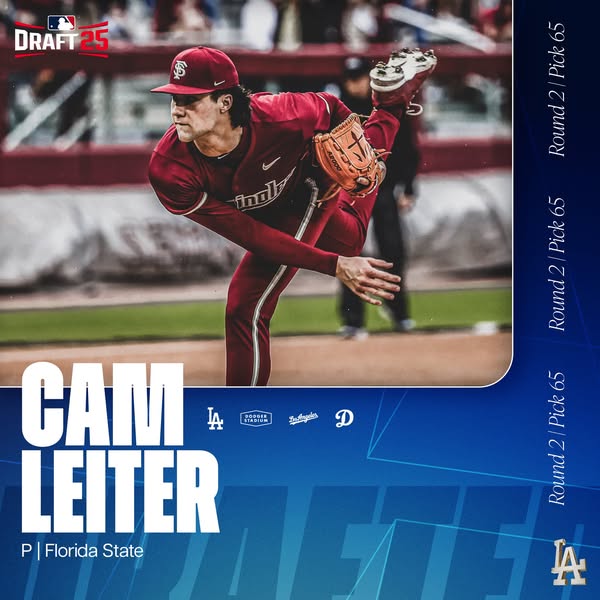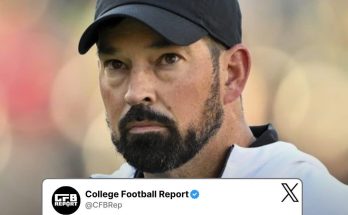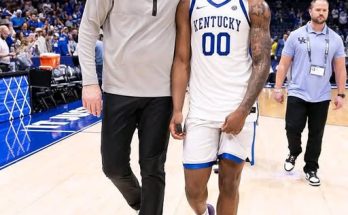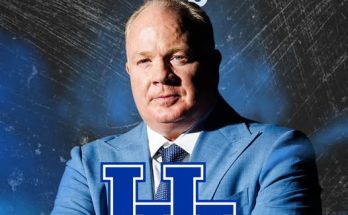The Los Angeles Dodgers have always taken pride in their ability to build through both smart scouting and an analytically driven approach to development. With the 65th pick in the second round and the 104th pick in the third round of the 2025 MLB Draft, they continued that tradition by selecting two promising prospects—pitcher Cam Leiter and outfielder Landyn Vidourek. Both picks speak volumes about the Dodgers’ continued commitment to blending upside with polish, tools with track record, and potential with character.
Cam Leiter enters the Dodgers’ system carrying the weight of both expectation and legacy. As the son of former major leaguer Mark Leiter and nephew of longtime MLB veteran Al Leiter, Cam has grown up surrounded by the game. But while his last name immediately turns heads, it’s his performance and poise on the mound that justify the Dodgers’ confidence in him. Leiter’s career at the University of Central Florida was a showcase of growth and dominance. Standing 6-foot-4 with a lean, athletic frame and easy mechanics, Leiter possesses the kind of arm action that scouts dream about—clean, repeatable, and efficient. His fastball routinely sits in the 93-96 mph range, and he has touched 98 on occasion, especially in high-leverage moments. Yet it’s not just velocity that defines him. His fastball carries strong ride and late life, particularly effective up in the zone against aggressive hitters.
What truly separates Leiter from many other college arms is his advanced pitch mix. His slider has developed into a legitimate out pitch, sitting in the mid-80s with tight horizontal break. It tunnels exceptionally well off his fastball, making it difficult for hitters to differentiate between the two until it’s too late. He complements those with a changeup that has progressed rapidly in the past year—showing late fade and arm-side drop, which neutralizes left-handed hitters. It’s a pitch that still needs consistency, but the raw shape is there and the intent is clear. He also occasionally flashes a slower curveball with depth, giving him a four-pitch mix that suggests starter potential at the next level.
From a makeup standpoint, Leiter checks all the boxes. Teammates describe him as cerebral and intense, a competitor who lives for the pressure moments and a student of the craft. The Dodgers have shown a pattern of targeting pitchers who pair stuff with intellect, and Leiter fits that mold perfectly. They believe that under their development system—perhaps the best in baseball—he can refine his command and further develop his secondary pitches. There’s a pathway for Leiter to become a middle-of-the-rotation starter within a few seasons, especially if he takes to the Dodgers’ renowned pitch-shaping technologies and biomechanical assessments. Some even see shades of a young Walker Buehler in him—not necessarily in arsenal, but in demeanor and drive.
While Leiter brings the pedigree and polish, the Dodgers’ third-round pick Landyn Vidourek offers an entirely different appeal: raw tools, athleticism, and projection. A high school outfielder out of Ohio, Vidourek burst onto the national radar during showcase season last summer, where his combination of speed, arm strength, and raw power stood out among peers. At 6-foot-3 and just under 200 pounds, he’s built like a classic modern outfielder—long-limbed and fast-twitch, with plenty of physical development still ahead of him.
Vidourek’s athleticism is evident the moment he steps onto the field. He posted sub-6.5 times in the 60-yard dash, routinely clocked elite sprint speeds during in-game play, and has demonstrated the kind of first-step quickness and closing speed that projects to center field long-term. While he has the frame to potentially grow into a corner outfield role, the Dodgers are likely to give him every chance to stick in center, where his instincts and range give him a high defensive ceiling.
Offensively, Vidourek is still a work in progress, but the upside is tantalizing. His swing is fluid with natural loft, and during pre-draft workouts and events like the Area Code Games, he showed burgeoning power to all fields. There are still concerns about his ability to consistently make contact, particularly against high-level off-speed pitches, but those concerns are typical for a prep bat facing elite velocity for the first time. The Dodgers are not drafting Vidourek for what he is right now—they’re drafting him for what he could become. With pro instruction, video analysis, and mechanical fine-tuning, he has the potential to develop into a true five-tool player.
What makes Vidourek even more intriguing is his background and maturity. Despite being one of the younger players in the draft class, he has earned praise for his work ethic and mental toughness. Coaches note that he’s the kind of player who shows up early, stays late, and genuinely wants to be great. He’s not just chasing the dream of making it to the major leagues—he’s studying how to get there. In that sense, the Dodgers may have found another hidden gem, similar to how they unearthed talents like James Outman and Gavin Lux in previous drafts. It’s no secret that Los Angeles has a knack for identifying high school players with latent potential and molding them into big leaguers.
Selecting Leiter and Vidourek with the 65th and 104th picks respectively also reflects the Dodgers’ broader organizational philosophy: a dual commitment to floor and ceiling. Leiter represents a near-ready arm who could climb quickly through the system and contribute to a rotation already teeming with talent. Vidourek, meanwhile, is a long-term investment—a player who might take three to five years to fully bloom but could ultimately become a game-changer if everything clicks. By hedging one pick with polish and another with projection, the Dodgers continue to build the kind of layered farm system that sustains success.
It’s also worth noting how these picks fit into the Dodgers’ larger draft strategy in 2025. With their first-round selection already invested in a high-upside college hitter, the organization appears to be spreading risk and building depth across the board. Their picks demonstrate an appreciation for both short-term value and long-term development—balancing college players who can move quickly with prep talents that need time. It’s a model that has worked exceptionally well for them over the past decade, leading to one of the most consistent and dominant runs in modern MLB history.
Cam Leiter will likely begin his professional journey at the Dodgers’ Arizona Complex League site before making his way to Rancho Cucamonga or Great Lakes. The focus will be on managing innings, refining his delivery, and learning how to sequence more effectively at the pro level. With his polish and pitchability, it’s not inconceivable that he could finish 2026 in Double-A if health and performance align. For Vidourek, the road is longer. He’ll begin with rookie ball, and the organization will take its time building out his strength, improving swing decisions, and teaching him how to translate his tools into skills. Patience will be key, but the Dodgers have never been shy about playing the long game with elite athletes.
Beyond the immediate talent infusion, these picks also tell a story about the kind of people the Dodgers want in their clubhouse. Both Leiter and Vidourek come with strong reputations as high-character individuals—coachable, accountable, and passionate about their craft. In a sport where mental fortitude can be the difference between A-ball and The Show, the Dodgers clearly value more than just the stat sheet. They want winners, grinders, thinkers, and learners.
Ultimately, it’s impossible to know with certainty how any draft class will pan out. Baseball is a game of failure, of relentless adjustments, of long bus rides and pressure-packed moments. But what separates the elite franchises from the rest is the ability to consistently make sound decisions on draft day—to find value where others see risk, to imagine upside where others focus on flaws. With the selections of Cam Leiter and Landyn Vidourek, the Dodgers once again showed why they remain the gold standard. They didn’t just draft two players; they drafted possibilities, and in the hands of their player development machine, possibilities often turn into stars.



